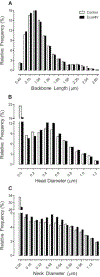A Rat Model of EcoHIV Brain Infection
- PMID: 33554966
- PMCID: PMC8191841
- DOI: 10.3791/62137
A Rat Model of EcoHIV Brain Infection
Abstract
It has been well studied that the EcoHIV infected mouse model is of significant utility in investigating HIV associated neurological complications. Establishment of the EcoHIV infected rat model for studies of drug abuse and neurocognitive disorders, would be beneficial in the study of neuroHIV and HIV-1 associated neurocognitive disorders (HAND). In the present study, we demonstrate the successful creation of a rat model of active HIV infection using chimeric HIV (EcoHIV). First, the lentiviral construct of EcoHIV was packaged in cultured 293 FT cells for 48 hours. Then, the conditional medium was concentrated and titered. Next, we performed bilateral stereotaxic injections of the EcoHIV-EGFP into F344/N rat brain tissue. One week after infection, EGFP fluorescence signals were detected in the infected brain tissue, indicating that EcoHIV successfully induces an active HIV infection in rats. In addition, immunostaining for the microglial cell marker, Iba1, was performed. The results indicated that microglia were the predominant cell type harboring EcoHIV. Furthermore, EcoHIV rats exhibited alterations in temporal processing, a potential underlying neurobehavioral mechanism of HAND as well as synaptic dysfunction eight weeks after infection. Collectively, the present study extends the EcoHIV model of HIV-1 infection to the rat offering a valuable biological system to study HIV-1 viral reservoirs in the brain as well as HAND and associated comorbidities such as drug abuse.
Conflict of interest statement
Disclosures
None of the authors have conflicts of interest to declare.
Figures



Similar articles
-
Identification of EcoHIV-Infected Cells in Microglia-Manipulated Transgenic Mice.J Vis Exp. 2024 Dec 20;(214):10.3791/67150. doi: 10.3791/67150. J Vis Exp. 2024. PMID: 39760359
-
Microglial HIV-1 Expression: Role in HIV-1 Associated Neurocognitive Disorders.Viruses. 2021 May 17;13(5):924. doi: 10.3390/v13050924. Viruses. 2021. PMID: 34067600 Free PMC article.
-
EcoHIV Infection of Primary Murine Brain Cell Cultures to Model HIV Replication and Neuropathogenesis.Viruses. 2024 Apr 27;16(5):693. doi: 10.3390/v16050693. Viruses. 2024. PMID: 38793575 Free PMC article.
-
The HIV-1 transgenic rat model of neuroHIV.Brain Behav Immun. 2015 Aug;48:336-49. doi: 10.1016/j.bbi.2015.02.020. Epub 2015 Feb 27. Brain Behav Immun. 2015. PMID: 25733103 Free PMC article. Review.
-
HIV-1 and drug abuse comorbidity: Lessons learned from the animal models of NeuroHIV.Neurosci Lett. 2021 May 29;754:135863. doi: 10.1016/j.neulet.2021.135863. Epub 2021 Mar 29. Neurosci Lett. 2021. PMID: 33794296 Free PMC article. Review.
Cited by
-
The Impact of Cannabis Use on Cognition in People with HIV: Evidence of Function-Dependent Effects and Mechanisms from Clinical and Preclinical Studies.Curr HIV/AIDS Rep. 2024 Jun;21(3):87-115. doi: 10.1007/s11904-024-00698-w. Epub 2024 Apr 11. Curr HIV/AIDS Rep. 2024. PMID: 38602558 Free PMC article.
-
Oxidative Stress in HIV-Associated Neurodegeneration: Mechanisms of Pathogenesis and Therapeutic Targets.Int J Mol Sci. 2025 Jul 13;26(14):6724. doi: 10.3390/ijms26146724. Int J Mol Sci. 2025. PMID: 40724974 Free PMC article. Review.
-
The potential role of HIV-1 latency in promoting neuroinflammation and HIV-1-associated neurocognitive disorder.Trends Immunol. 2022 Aug;43(8):630-639. doi: 10.1016/j.it.2022.06.003. Epub 2022 Jul 12. Trends Immunol. 2022. PMID: 35840529 Free PMC article. Review.
-
Identification of EcoHIV-Infected Cells in Microglia-Manipulated Transgenic Mice.J Vis Exp. 2024 Dec 20;(214):10.3791/67150. doi: 10.3791/67150. J Vis Exp. 2024. PMID: 39760359
-
Disrupted Decision-Making: EcoHIV Inoculation in Cocaine Dependent Rats.Int J Mol Sci. 2022 Aug 13;23(16):9100. doi: 10.3390/ijms23169100. Int J Mol Sci. 2022. PMID: 36012364 Free PMC article.
References
-
- Joseph SB, Swanstrom R The evolution of HIV-1 entry phenotypes as a guide to changing target cells. Journal of Leukocyte Biology. 103 (3), 421–431 (2018). - PubMed
-
- Albritton LM, Tseng L, Scadden D, Cunningham JM A putative murine ecotropic retrovirus receptor gene encodes a multiple membrane-spanning protein and confers susceptibility to virus infection. Cell. 57, 659–666 (1989). - PubMed
Publication types
MeSH terms
Substances
Grants and funding
LinkOut - more resources
Full Text Sources
Other Literature Sources
Medical
